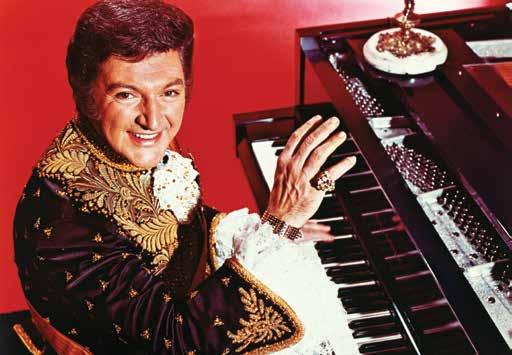
10 minute read
Liberace: The Great Showman of Sin City
Liberace’s home was glamorously decorated and had a piano shaped swimming pool. (Photo courtesy of Pictorial Press Ltd / Alamy Stock Photo)
LIBERACE:
THE GREAT SHOWMAN OF SIN CITY
by TERRY PARRETT
“See, Johnny, we figure that entertainment will be a big factor in drawing gamblers to the casino. And we hope you’ll sign a contract to appear five times a year. Perhaps convince some of your friends in movies to do the same. We’re counting on you…” Michael Corleone to Johnny Fontane, “The Godfather”.
While Las Vegas and entertainment may be inseparable today, this wasn’t always the case. From the legalization of casino gambling in 1931, through the early 1950s, entertainment was treated by the casinos as more of an afterthought than a reason for visiting. Casino managers with an eye on the bottom line initially thought that anything that would keep players off the casino floor was a drag on profits. It wasn’t until the early 1950s when casinos realized that offering headline entertainment would be a terrific way to bring in guests who might not be inclined to frequent a casino. It was hoped that these guests, once in the door, would end up out on the gaming floor, and a new gambler would be born. Of all the entertainers who graced a Vegas stage, perhaps no one transformed the entire concept of Las Vegas entertainment more than “Mr. Showmanship”, Wladziu Valentino Liberace, known better by a single name, Liberace.
Liberace, also known as “Lee” to his friends, and “Walter” to his family, was born in 1919. By the age of 4, he had already begun to demonstrate an unmistakable gift for the piano. Happily, young Walter had been born to parents who were also talented musically- his father Salvatore (also known as Sam) played the French Horn when he could find paying gigs, and his mother Frances had been a concert pianist prior to marrying. Unfortunately, challenging financial times didn’t allow the family
to provide their young prodigy with piano lessons, or even a record player. Nonetheless, Sam encouraged his son to practice, taking the family to concerts when he could. By the age of seven, Liberace was studying the work of legendary Polish pianist Paderewski, and by eight, he was inspired by meeting his idol backstage after a concert in Milwaukee. This proved to be a seminal moment in Liberace’s life, and in his own words, “I began to practice with a fervor that made my previous interest in piano look like neglect.”
Even at this young age, Liberace’s talent was undeniable, and he was introduced to Florence Bettray-Kelly, who became his tutor. Bettray-Kelly was able to secure
Liberace’s trademark candelabra appears on his piano during performances. (Photo courtesy of Pictorial Press Ltd / Alamy Stock Photo)

Liberace a scholarship to the Wisconsin College of Music, ensuring his musical education in spite of the hard-economic times brought on by the Great Depression. At 10 years of age, Liberace performed his first professional paying gig, at the Wisconsin Theater. During the 1930s, Liberace was able to help out his family financially, despite still being in his teens at the time and by 1940, when it was clear that a career in show business was in the cards for Lee, he headed to New York. The 1940s were at times challenging for Liberace, as they were for any struggling young artist, but they were instrumental in developing his unique onstage persona. At the time, Lee was having difficulty choosing between a career as a classical pianist as opposed to a nightclub entertainer. His mother Florence suggested a middle ground- “Play some classics, then give them something popular.” A few years earlier, at a concert in Wisconsin, Liberace asked the audience at a classical concert what they would like to hear as an encore. Someone in the crowd yelled out “Three Little Fishies”, a popular novelty song at the time. Liberace obliged by playing the song in the style of several classical composers including Johann Strauss and Franz Liszt. The audience loved it, and this experience, combined with Florence’s advice, molded Liberace’s career trajectory. For the rest of the decade, Liberace honed his act in night clubs across the country, learning how to please crowds with not only his exceptional musical ability, but with his wit, his voice, and his appearance.
Since his high school days, Lee had been a natty dresser, and his onstage outfit at the time usually consisted of a tux and tails, with a personal touch like a top hat or colorful pocket square. While performing as intermission pianist for a headliner named “Hildegarde”, she advised him that he needed a “gimmick”. Liberace recalled a candelabra that had been prominent in several scenes in the Chopin biopic “A Song to Remember”, and he rushed out to an antique store to find such a piece. After that, nearly every review he received mentioned the item, and along with his ever-flashier outfits, it became his trademark.
By this time, Liberace was attracting attention on a national scale from entertainment industry insiders, and Maxine Lewis, entertainment director of the Last Frontier Hotel in Las Vegas who offered him a job for $750 a week. After the first week, Lewis doubled his salary and extended his run by six extra weeks. This engagement began the lifelong love affair between Las Vegas and Liberace.
As the 1950s introduced television into the homes of American families, fledgling networks looked around for content to offer their audiences. As Liberace’s fame and popularity grew through his live appearances at resorts and casinos in Las Vegas and Lake Tahoe, as well as concert halls around the country, he began appearing as a guest on popular TV variety shows. Soon after, he was offered his own nationally televised show. “The Liberace Show” first aired in 1951, and within a year, it had more viewers than “I Love Lucy” and “Dragnet”. The show was surprisingly simple compared to the stage spectacles associated with Liberace in later years. Dressed in a black tuxedo, he would play a few songs, generally a mix of some classical music and some of the popular songs of the day, and chat with the audience at home, telling stories about his life or childhood, sometimes relating some relevant information about the music he was playing. Liberace’s brother, George, would occasionally accompany him on the violin. Prior to the show, Liberace was making around $50,000 annually; once the show was a success, his income skyrocketed into the millions. The combination of his talent, self-deprecating humor, and dazzling costumes endeared him to viewers around the country. His popularity grew to the point where he was even lampooned in a classic Bugs Bunny cartoon, “Hyde or Hare”, where in one scene, Bugs sits at a piano, places a candelabra on it, and in a familiar voice, intones “I wish my brother George was here.”
In 1956, Liberace made history by becoming the highest-paid entertainer in Las Vegas history, signing a deal with the Riviera for an eye-popping $50,000 per week. Many consider this to be the first Las Vegas residency, preceding similar arrangements by stars like Celine Dion and Elton John by nearly 50 years. His show at the Riviera featured ten costume changes during the 80-minute show, another “first” that would be imitated by other performers through the years. An interesting bit of Las Vegas trivia- when Liberace signed with the Riviera, his former Las Vegas employers at the Last Frontier decided they needed to shake things up in light of the formidable competition, so they changed their name to The New Frontier, and hired an upand-coming singer as their new headliner. That performer’s name? Elvis Presley. At the time, Elvis wasn’t quite as glitzy as he turned out to be and only lasted three days at the New Frontier. Liberace went to one of his shows and famously told him, “You need more glitz in your act, kid.” Elvis didn’t return to the Strip until 1969, when he took that advice and bumped Liberace’s residency to the #2 slot, until 1977 when Lee broke Elvis’s record again.
During Liberace’s tenure at the Riviera he incorporated many on-stage and off-stage innovations that have become an integral part of not only Las Vegas entertainment, but American culture at large. Liberace’s love of jewelry and onstage costumes can be seen today in what we now call “bling”. Prior to Liberace’s performance, classical and popular music lived in separate worlds, performed for totally different audiences. Liberace proved that there was an audience for both, even during the same performance. Liberace loved to share his home life with his fans, taking them on virtual tours of his six homes, a concept which would eventually lead to “Lifestyles
Liberace made history by becoming the highest-paid entertainer in Las Vegas history. (Photo courtesy of Pictorial Press Ltd / Alamy Stock Photo)

of the Rich and Famous”, and even “MTV Cribs”.
While Liberace’s television show eventually faded, his popularity in Las Vegas continued to grow. Year after year, Liberace tried to outdo himself, adding more outrageous costumes and more elaborate onstage antics. Liberace was the first to bring an automobile onto a Las Vegas stage, and by the mid-1980s, he was earning $300,000 a week. He continued touring into his final years, and his last tour which concluded at Radio City Music Hall and grossed $2.5 million.
As his fortune grew, Liberace took delight in amassing a collection of luxury homes and automobiles. In 1976, he created “The Liberace Foundation for the Creative and Performing Arts”, which provided scholarships and grants to promising young artists. In 1979, he opened “The Liberace Museum”, which allowed visitors to see some of his many pianos, cars, costumes, and jewelry. It quickly became Nevada’s third most-popular tourist attraction, outdone only by Hoover Dam and the Vegas Strip itself. After Liberace’s untimely death in 1987, many more of his personal items were added to the collection, and the museum eventually tripled in size. By 2010, changing economic conditions forced a change in the operation, and the Liberace Foundation began branding a travelling museum collection of Liberace artifacts which have been seen around the world. Liberace fans can still visit the Liberace Garage as well as a touring exhibit in Las Vegas, which was ranked as the #1 rated museum in town by Trip Advisor.
While Liberace himself may no longer be with us, his spirit and influence can be seen and felt all over Las Vegas. From the elegance of the Bellagio Fountains, to the glitz and flashy costumes at revue shows, to the concept of the artist residency, all of these can be traced back to Liberace. His sense of showmanship influenced performers from Elvis Presley- whose tenure at The New Frontier was floundering until Liberace gave him some tips about costuming and showmanship, as well as his first gold lame jacket- to Little Richard, James Brown, Freddie Mercury, and most notably, Elton John. More than possibly any other performer, Liberace was responsible for transforming Las Vegas from a dusty gambling town in the desert into the “Entertainment Capital of the World”.
YOU’VE ARRIVED.




Ameristar Casino offers an exciting & clean place to play along with stunning views of the Mississippi River and bridges. Our restaurants offer delicious southern dishes for both dine-in or take-out, and you can rest in luxury on the banks of the Mississippi at the Ameristar Hotel. In the casino, play the way you want with almost 800 socially distanced slots, and all of your favorite table games. Or, for the ultimate sports betting experience, spend some time at The End Zone, a full-service sportsbook with 17 convenient betting kiosks, a spectacular viewing area with the largest HD screens around, and an expansive sports bar with lots of brews on tap!
WE’LL SEE YOU WHEN YOU GET HERE!
4116 WASHINGTON ST VICKSBURG, MS 39180 | AMERISTAR.COM






